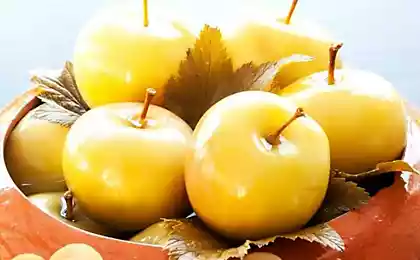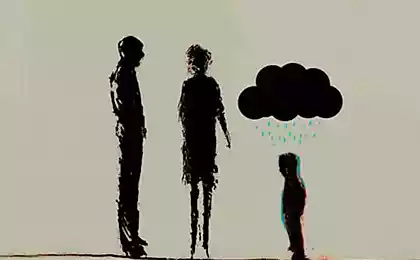173
A parable about how ridicule and mockery work on a person
We live in a world where ridicule Others have become quite normal. Any hamstrings in a particular environment are almost an entrance ticket to a narrow circle of the chosen. What to do is a form of social adaptation. And in general, people do not miss the opportunity to assert themselves at the expense of others.

This can be treated differently. You can be thick-skinned and morally strong, so you'll just laugh back. But most people perceive this with resentment and are unable to adequately respond. That's why we're editorial. "Site" They decided to tell a parable about what a supposedly harmless mockery can turn out to be.
At the beginning of the lesson, Maria Ivanovna put on teacher-table She asked the children how the apples differed from each other. They couldn’t answer because the apples looked like each other. Then the teacher took one of the apples, called it bad and threw the earth. The kids were staring at her.

Marya Ivanovna picked up the apple and handed it over to the student at the first desk, asking him to find what he did not like in it and throw it on the ground. The boy did as the teacher said. She told me to pass the apple on. And every time the children found something bad in the apple.
Someone said, stain. Someone else said it smelled sour. And so on and so forth. In the end, the long-suffering fruit returned to Marya Ivanovna and she put it again on her table, next to the first apple. She looked around the class and asked, “Now, kids?” Are these two apples different?

But the children did not find any special differences: both fruits are green in color, about the same shape. From a distance it is impossible to make out which of them is broken. Outwardly, it seemed the same as the first. Maria Ivanovna cut the apples in half and showed the children.

The first apple turned out to be white inside, and the children agreed that it looked better than the broken apple, they were ready to eat it. But the second one inside was broken. Essentially, it held only thanks to the outer skin, which was hard enough to withstand all the blows. No one wanted to eat the darkened flesh. Then the teacher said,
“We made the apple like that ourselves. We're the ones who figured out why it's bad. We threw him on the floor. So we're to blame for everything that happened to him. Instead of an apple, imagine a human being. The same thing happens to him when we poison him, insult him or try to humiliate him. But there are very few people out there who can show it! ?

From the editorial board, I think it's great. primerIt can explain why ridicule is not always pleasant. As for children, they can be incredibly cruel. Just because you don’t know the moral boundaries. Maybe they should know this story too? Some of them may have been ridiculed and humiliated.

Be sure to write in the comments about whether you had to endure ridicule stranger. Or were they your own friends? How did you manage that? And then read our article about what events from childhood still haunt you. And thank you for staying with us!

This can be treated differently. You can be thick-skinned and morally strong, so you'll just laugh back. But most people perceive this with resentment and are unable to adequately respond. That's why we're editorial. "Site" They decided to tell a parable about what a supposedly harmless mockery can turn out to be.
At the beginning of the lesson, Maria Ivanovna put on teacher-table She asked the children how the apples differed from each other. They couldn’t answer because the apples looked like each other. Then the teacher took one of the apples, called it bad and threw the earth. The kids were staring at her.

Marya Ivanovna picked up the apple and handed it over to the student at the first desk, asking him to find what he did not like in it and throw it on the ground. The boy did as the teacher said. She told me to pass the apple on. And every time the children found something bad in the apple.
Someone said, stain. Someone else said it smelled sour. And so on and so forth. In the end, the long-suffering fruit returned to Marya Ivanovna and she put it again on her table, next to the first apple. She looked around the class and asked, “Now, kids?” Are these two apples different?

But the children did not find any special differences: both fruits are green in color, about the same shape. From a distance it is impossible to make out which of them is broken. Outwardly, it seemed the same as the first. Maria Ivanovna cut the apples in half and showed the children.

The first apple turned out to be white inside, and the children agreed that it looked better than the broken apple, they were ready to eat it. But the second one inside was broken. Essentially, it held only thanks to the outer skin, which was hard enough to withstand all the blows. No one wanted to eat the darkened flesh. Then the teacher said,
“We made the apple like that ourselves. We're the ones who figured out why it's bad. We threw him on the floor. So we're to blame for everything that happened to him. Instead of an apple, imagine a human being. The same thing happens to him when we poison him, insult him or try to humiliate him. But there are very few people out there who can show it! ?

From the editorial board, I think it's great. primerIt can explain why ridicule is not always pleasant. As for children, they can be incredibly cruel. Just because you don’t know the moral boundaries. Maybe they should know this story too? Some of them may have been ridiculed and humiliated.

Be sure to write in the comments about whether you had to endure ridicule stranger. Or were they your own friends? How did you manage that? And then read our article about what events from childhood still haunt you. And thank you for staying with us!
In the old days, the best piece was given to parents, which is behind this tradition.
We go home from school with our daughter, and she says she's hungry and can't stand it anymore.






















